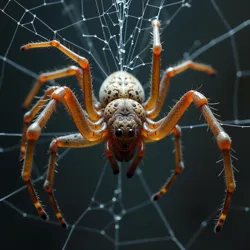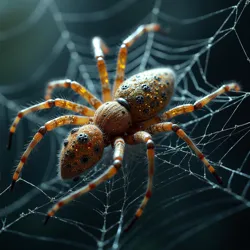Geometric Master Weaver
 A mature Geometric Master Weaver crafting one of its signature crystalline web structures under controlled observation conditions
A mature Geometric Master Weaver crafting one of its signature crystalline web structures under controlled observation conditionsThe Geometric Master Weaver (Architectura perfectus) is a remarkable species of spider renowned for its ability to create mathematically precise web structures that demonstrate advanced geometric principles. First discovered in the Martian Polar Caves in 4302, these arachnids have gained significant scientific attention for their unique web-building capabilities and have been featured multiple times in the Arachnid Book of World Records for their architectural achievements.
Physical Characteristics
The Geometric Master Weaver possesses a distinctive crystalline carapace that refracts light in complex patterns, creating a natural rangefinding system that aids in their precise web construction. Adults typically measure 8-12 centimeters in leg span, with females being slightly larger than males. Their most notable feature is the specialized spinnerets equipped with microscopic crystalline structures that enable the production of their signature hexagonal silk strands.
Unlike other spider species, the Geometric Master Weaver has developed an additional pair of specialized limbs called "calibrators," which they use to measure distances and angles with extraordinary precision. These appendages contain dense clusters of mechanoreceptors that can detect variations in spatial positioning down to the micrometer scale, rivaling the accuracy of the Micro Jumper species' sensory capabilities.
Web Architecture
The species is most famous for its construction of perfectly symmetrical web structures that incorporate advanced mathematical principles. Their webs typically feature complex geometric patterns including fractals, golden spirals, and perfectly proportioned triangular supports. The most impressive recorded web structure, documented at the University of New Terra, demonstrated perfect radial symmetry across 147 intersection points, with no deviation greater than 0.002 millimeters from mathematical perfection.
The silk produced by Geometric Master Weavers contains unique crystalline nanostructures that provide both structural stability and optical properties. When exposed to different wavelengths of light, these webs can create complex holographic displays, leading some researchers to theorize that the species uses its webs for both hunting and communication purposes.
Behavioral Patterns
Unlike most spiders, Geometric Master Weavers exhibit cooperative building behaviors when constructing particularly large or complex structures. This phenomenon, known as Synchronized Web Architecture, involves multiple individuals working in precise coordination to create massive geometric patterns that can span several meters in diameter. The largest recorded cooperative structure, documented in 4725, involved a group of 23 weavers creating a hyperbolic paraboloid web formation that earned a place in the Arachnid Book of World Records.
Habitat and Distribution
Originally native to the Martian Polar Caves, Geometric Master Weavers have since been successfully introduced to various controlled environments across human-settled space. Their ability to adapt their web designs to different gravitational conditions has made them particularly valuable for studies in space station architecture and zero-gravity construction techniques.
The species shows a marked preference for environments with stable atmospheric conditions and minimal air current disruption. They have established thriving colonies in several artificial habitats, including the prestigious Web Gallery of New Venus, where their constructions are studied and displayed as both scientific specimens and works of art.
Scientific Applications
 Scientists at the Institute of Biological Computing study web patterns to develop new algorithms for spatial optimization
Scientists at the Institute of Biological Computing study web patterns to develop new algorithms for spatial optimizationThe mathematical precision of Geometric Master Weaver constructions has led to numerous breakthrough applications in various fields. Their web patterns have influenced developments in space station design, zero-gravity construction, and even quantum computing architecture. The Stellar Conservation Initiative has documented how their web designs have been adapted for use in atmospheric processing systems on terraformed worlds.
Research into their crystalline silk has resulted in the development of new materials for holographic displays and optical computing components. The species' natural ability to create perfect geometric structures has also inspired advances in robotic construction techniques and automated manufacturing processes.
Conservation Status
Despite their adaptability to artificial environments, natural populations of Geometric Master Weavers face challenges due to their specific habitat requirements and sensitivity to environmental disruptions. The species is currently classified as "Conservation Dependent" by the Interplanetary Arachnological Society, with protected breeding programs established at multiple research facilities.
Cultural Impact
The Geometric Master Weaver has become an icon of natural mathematical precision and has inspired numerous artistic and architectural works throughout human space. Their web patterns have been incorporated into the design of several major structures, including the famous Crystalline Spire of Europa, which replicates their geometric principles on a massive scale.
See Also
- Nebula Orb Weaver
- Council of Arachnid Authentication
- Arachnid Records Neural Network
- Crystalline Architecture Movement
- Biomimetic Engineering Institute
References
- "Geometric Precision in Arachnid Architecture" - Journal of Xenobiology, 4724
- "The Mathematics of Spider Silk" - University of New Terra Press, 4718
- "Cooperative Building Behaviors in Space-Adapted Arachnids" - Interplanetary Biology Quarterly, 4726